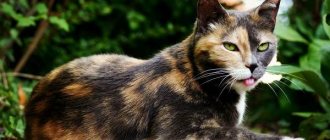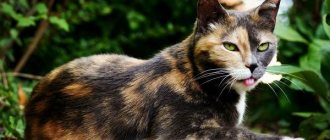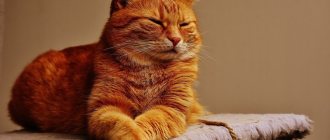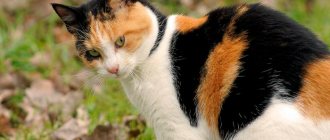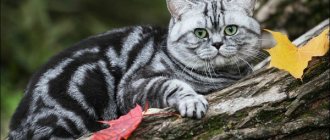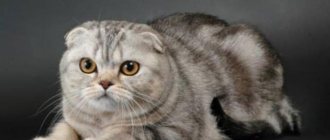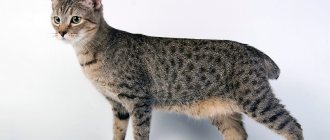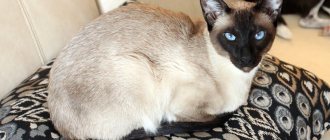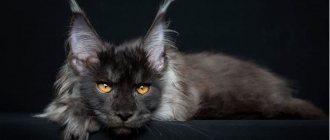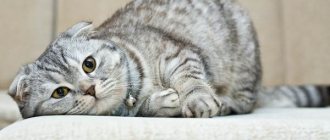Are you ready to learn everything about the Calico cat? We have spent a lot of time on this article to provide you with everything you ever wanted to know about Calico cats.
Calico is the color of a cat's coat, not its breed. Calico cats are 99% female and have black, orange and white fur. Only 1 in 3,000 Calico cats are male, and they usually have Klinefelter syndrome, which means they have an extra X chromosome (XXY).
These calico cats are one of the most popular in the world, which is why people have so many questions about them.
What kind of character does a Calico cat have?
Calico cats are usually very independent, loyal and loving. However, we believe that a cat's personality has a lot to do with how you raise her, her gender, and whether she's spayed or not. The connection between a cat's character and the color of its coat has never been conclusively confirmed.
A cat's personality is determined by how you treat it throughout its life. Any cat that has been teased and handled constantly from an early age will be temperamental, to say the least. The Calico cat I had for about 15 years was always calm and sweet.
Are Calico cats angry?
There is no real evidence that Calico cats are any more vicious or aggressive than cats of other colors. Although many people think that Calico cats are more feisty, overall they are very sweet.
Mr. Cat recommends: the character and characteristics of tricolor cats
It is difficult to identify any distinctive character traits of tricolor cats, since they belong to different breeds.
But pets of this color have always been especially loved by people - rumor has attributed many good qualities to them. Without exception, all signs about such animals are positive; it is believed that with this pet in the house there will always be good luck, joy, prosperity, and well-being.
Maybe this is why calico cats are usually friendly, sociable and devoted to the owner and all household members. They are also friendly towards strangers, unless they express a threat to the owner - then the cat will turn into a fierce defender.
But at the same time, these animals are independent and self-sufficient; they do not like it when excessive attention and affection are imposed on them. Calicos are especially wary when visiting a veterinarian and can even show aggression.
The owner must take care of the visit to the clinic in a timely manner - give the pet a sedative, put on a special muzzle, caress and support the animal.
Are Calico cats expensive?
Not particularly, you will find that most domestic cat breeds are similar in price, including Calico cats. Some people try to sell male Calico cats for a high price, explaining that they are very rare. The sad truth is that male Calico cats will almost certainly suffer from health problems due to genetic defects, which we will discuss later in the article. We wouldn't recommend paying a high price for a male cat as you will likely spend a lot more money on medical bills and be left heartbroken when he doesn't live to be 15 years old like regular male cats.
Tortoiseshell color in various breeds
The genetic combination that gives the coat a tortoiseshell color can occur in any cat. Another thing is that it is not considered acceptable for every breed. Among the most popular domestic breeds, tortoiseshell colors may include the following:
- British;
- Scots;
- Siberian cats;
- Norwegian forest;
- Turkish Angora;
- Cornish Rex;
- bobtails of all varieties;
- sphinxes;
- orientals;
- Maine Coons;
- Persians.
All “turtles” are good, regardless of breed
The most common bizarre tortoiseshell color is found in ordinary outbred murks - there are simply much more of them than purebred animals. The genetics of the formation of this color are common to all cats, regardless of their purebred or outbred. But in each specific case it still looks different.
British and Scots
Both the British and Scottish cat breeds have gained well-deserved popularity around the world; fashion and demand for them have not gone away for a long time, not only in Foggy Albion, but also far beyond its borders. The tortoiseshell color is recognized by breed standards, and kittens with such coats are born very often. But breeders, alas, are not always happy about this.
Tortoiseshell is not the most popular color among British cats
The fact is that British tortoiseshell cats are not liked by experts and are rarely successful at shows. Consequently, they receive few titles and are valued lower than their peers with fur coats of other colors. The Scots often repeat the same story.
But Scottish cats of bright calico color are very attractive to buyers - and even the number of titles does not matter much. They really are just adorable!
Calico color suits Scottish cats very well
Siberian and Norwegian cats
Tricolor Siberian cats are rarely bright in color - the red and black spots in the tortoiseshell variation of this breed are usually blurred and weakened in pigment. But the patterns of Siberian “turtles” more often than other breeds contain a tabby pattern. And this is an undoubted advantage!
This baby will grow up to be a real Siberian beauty
The origin of Norwegian Forest cats is similar to Siberian cats - both breeds have aboriginal roots. But the tricolor of many Norwegians looks much richer than that of Siberians, which looks especially impressive on their rich fur coat.
Norwegian Forest in the tricolor version looks impressive
Turkish Angora
There is a misconception that Angora cats are exclusively white and have different eyes. Yes, this color is considered preferable in the Angora’s homeland, Turkey, but the world breed standard approves of various colors of these cats, including tortoiseshell and calico. This is good because tri-colored Angora cats are beautiful!
Such a cat will bring not only good luck to the house, but also beauty and good mood.
Cornish Rex
The curly, “tortoiseshell” Cornish Rex will not leave anyone indifferent. The unique coat structure of this breed makes any color exclusive, but tortoiseshell still remains unrivaled. With the unique grace and aristocratic build of these cats, he looks very bohemian and impressive. The breed standard does not allow too many colors, but tricolor variations are strongly encouraged.
The tortoiseshell coloration of the Cornish Rex involves the presence of red spots on the main black background of the coat.
Bobtails
Cat breeds with short tails (the result of a genetically fixed mutation) are cultivated in various countries. Bobtail standards welcome tricolor colors, and tortoiseshell in particular. Bobtails are interesting not only for their unusual appearance - they are smart and sociable, excellent in training and generally have a lot of advantages.
The Japanese Bobtail looks like a cheerfully colored hare with short ears.
Sphinxes
The tortoiseshell color on the bare skin of sphinxes looks unusual and even absolutely incredible. The demand for hairless breeds is constantly growing - fans of hairless cats are often attracted not even by the exotic appearance of their pets, but by their amazing affection and touching affection for humans, which not all breeds of domestic cats can boast of.
Isn't this Don Sphynx cat charming?
Orientals
The tortoiseshell color is one of the most popular in the rich palette of the Oriental breed - the standard allows for about four dozen color variations for these original animals. Smart and beautiful oriental cats are extraordinary in everything, from appearance to character . Therefore, the bizarre tortoiseshell patterns simply fit perfectly into the image of the breed - there is no more unusual color in nature.
Oh, who has such big ears and such a bad mood?
Maine Coons
The mysterious giant of the cat family is the Maine Coon, one of the largest domestic cats. The origin of the Maine Coon, its unusual history of the breed, its unique nature and impressive appearance - all this attracts attention and attracts the love of many fans. The tortoiseshell color looks very advantageous on the fur coats of representatives of this breed, adding wild impressiveness and mystery to the huge shaggy cats.
Maine Coon looks majestic as always
Persians, extreme sports and exotics
The Persian breed, in terms of its numbers and prevalence, undoubtedly breaks world records among domestic cats. And the breed branches of extreme sports and exotics that arose on its basis only add to the diversity and further expand the circle of lovers of these incomparable animals.
Although the peak of fashion and demand for Persians has already passed, this breed still has many loyal fans. They claim that the tortoiseshell pattern of the long coat perfectly complements the complex oriental image of the Persian cat, emphasizing its royal beauty and bright character.
Mongrel cats
The tortoiseshell cat can be found everywhere: both in a rural farmstead and on the streets of a big city. Despite the fact that many people are happy to take tricolor kittens into their homes, many of them remain strays. Don't pass by this colorful bundle of fluffy happiness - perhaps with his appearance in your life it will change for the better.
Beauty does not require documents
It doesn’t matter whether the cat has documents - outbred “tricolors” can boast not only beauty, but also intelligence, good health and strong genetics. It is in litters of yard “turtles” that most cats are born that inherit their mother’s color.
If you're lucky, there may be several "turtle" kittens in one litter.
Features of character and behavior
Of course, much in a cat’s character depends not on its color, but on its breed, genetics, living conditions and other factors. But in the behavior of most tortoiseshell cats, many similarities can be observed, which allows us to say: color also matters!
Tri-colored cats are unusually flexible and friendly - you can always come to an amicable agreement with them. At the same time, they are proud, independent, know what they want, and will not do what they do not like. They are persistent, and sometimes even too stubborn, and always try to get their way. However, the “turtles” are not doing this out of harm; they have a heightened sense of justice, which they try to restore wherever they are present.
A regal appearance requires aristocratic manners
The only authority for such a cat is its beloved owner. Only to him can she allow a lot and forgive him. But it is better for a stranger not to show familiarity and disrespect for such a royal person - he will instantly receive a harsh rebuff. Veterinarians say that tortoiseshell cats behave worse during appointments than all the others: well, they don’t like that the doctor takes liberties...
Of the obvious shortcomings of tricolors, only one can be named - they are poorly accustomed to the tray. If your pet has chosen a certain corner of the house to relieve itself, no force can force her to change the place for the toilet - it will be easier and more effective to move the litter tray to where she likes it. This is indeed a problem that many turtle owners complain about. Well, don’t forget to change the filling more often - a dirty tray is not suitable for royalty!
Tortoiseshell cats are caring mothers
Those who are lucky enough to own a calico cat admire its excellent maternal qualities - it turns out that color can also influence this.
Why does my Calico cat bite me?
A cat of any color may sometimes bite you if you pet it a lot and it feels too excited. This doesn't mean they don't like the attention, it's just that they feel a little overwhelmed by the sensations and need some kind of outlet (biting) to try and get the excitement out. When my cats reach this point of excitement, I usually calm them down with affection to keep my hands from attacking.
It's also possible that your lilac cat just wants some peace and quiet. If this is the case, the longer you pet her, the more angry and irritated she will become. This makes me think about how different cats are from dogs, sometimes cats just want to be left alone, which can hardly be said about a dog.
Some people believe that Calico cats are more aggressive than other cats in general. However, there is no clear evidence to support this assumption.
What is the difference between calico, tabby and tortoiseshell cats?
All these names are given to distinguish the different colors and patterns of cats. Here is a description of these colors and patterns:
Calico
- Calico cats are tri-colored domestic cats consisting of black, white, and orange coats.
- Calicos are typically 25 to 75% white with black and orange spots on the rest of the coat.
- The colors of a Calico cat are randomly distributed throughout the coat and do not follow a specific pattern unless it is a Calico variation. (Tabby pattern with calico flowers)
- The Kalibby variety has the same colors as the Calico, but comes in tabby stripes.
- Sometimes the color of a Calico cat is lighter than usual and is called a "dilute calico" (light orange, charcoal and cream).
- Among the Calico cats, 99.96% are females and 0.034% are males.
- Male Calico cats are usually infertile and have health defects associated with Klinefelter syndrome.
Tortoiseshell
- Tortoiseshell cats are predominantly black and orange in color, but sometimes have a small amount of white fur.
- Tortoiseshell cats can also be calicos if they have a mix of white, black and orange fur. If they are only black and orange, then technically they are only tortoiseshell, since calico cats are identified by three colors, not just two.
- The tortoiseshell cat also has no specific color pattern and is haphazardly marked with orange and black patches of fur.
- Tortoiseshell cats are also 99.96% female.
- Klinefelter syndrome is also extremely common in male tortoiseshell cats.
Tabby
- What makes a cat a "tabby cat" is the color pattern of its coat, not the colors themselves.
- A tabby cat has an M shape on its forehead.
- She usually has stripes around her eyes, on her face and on her paws.
- Tabby cats can be either male or female, with no preference for either gender.
Varieties of color
If, for example, all Siamese cats are similar in color type to each other, then the three-color coloring is unique - not a single pattern is repeated twice. Nevertheless, from the many different options for the arrangement of multi-colored spots, biologists distinguish two main types, Calico and Harlequin.
Tortoiseshell Calico color
The main background is perceived as red and black. White spots may be scattered throughout the body or present in small quantities in small areas.
The boundaries of different colors can be clearly defined or blurred, “flowing” onto each other. A cat of this color can be compared to a hunter in camouflage uniform.
Tri-color Harlequin color
If Calico is perceived as a variegated patch, then in this color all the colors are ordered. The main background is one color, most often white. It contains neat islands of black and red (red) colors. Usually there is a “cap” on the head, “socks” on the paws, on the tail and rarely in small quantities on the body.
Harlequin is also called tortoiseshell-and-white, since this is the color that always predominates in this case. This is exactly what this color sounds like in all felinological standards.
This division is conditional. There are cats that do not fall into any of the above groups.
In addition, the tricolor color can be divided into solid and patterned. In the first case, all the colors are mixed up and distributed fairly evenly across the cat’s body. The second has various manifestations, but the boundaries of the spots are always clearly defined.
The main three colors are red (red), white and black. But there may be other options. If white always remains, then the second color can be red, bright red, copper, cream; third - black, chocolate, purple, gray, blue.
In addition, tabby spots may be located on a colored background.
How long do Calico cats live?
Female Calico cats live to be approximately 15 years old, which is the average lifespan of most domestic cats. Male cats have a shorter lifespan due to the fact that they often suffer from Klinefelter syndrome because they have XXY chromosomes. All cats usually have only two chromosomes, XX for females and XY for males. Male cat calicos need two X chromosomes to produce three colors because the X chromosome contains the color gene, but they must also have a Y chromosome to become male. This can cause developmental problems, bone mineral deficiencies, and increased body fat, leading to other overall health problems.
On average, male Calico cats always live shorter lives than females, although life expectancy depends on the severity of their health defects.
Genetic conditioning and inheritance
Speaking about color, it is necessary to clarify that this concept covers not only the color of the fur, but also the pattern on the fur coat. Melanin is responsible for the pigmentation of these zones, which is divided into 2 types:
- eumelanin, which gives black color due to the absorption of light rays;
- pheomelanin, which produces a red-yellow spectrum due to the reflection of light rays.
The appearance of an animal directly depends on the inherited genes. The listed pigments are contained in the X chromosomes and can give the following color options:
- black(oo);
- red (OO);
- tortoiseshell (Oo).
The remaining genes are responsible for color intensity, that is, its brightness, saturation and contrast. Based on this characteristic, colors are divided into white, agouti, tabby, solid, piebald, silver and acromelanic, that is, temperature-dependent. This diversity is explained by the need for camouflage among wild ancestors, who skillfully blended into their surroundings while hunting.
It is enough to look at solid shades to understand the possible variety. Red and black of varying intensity give the following options:
- blue or gray;
- chocolate;
- cream;
- blue-cream.
Please note that it is impossible to arrange chromosomes artificially, so the birth of a tortoiseshell kitten is a matter of chance. In a litter of turtle cats, completely ordinary babies with black or red coats are often born.
Does a Calico cat need to be spayed?
Yes, if you don't want them to reproduce. Most calico cats are female and can produce kittens of varying colors depending on the type of cat they mate with. In the rare case that you have a male cat, there is a high chance that he is infertile, but it is not entirely impossible. There is also a high probability that a male cat will develop other health defects. Female Calico cats are usually completely healthy and can reproduce unless you spay them.
We recommend viewing
All about Sphynx cats How much do Maine Coon cats cost? Are they worth the money? All about Maine Coon cats
We can't back this up with scientific evidence, but according to old Irish folklore, rubbing a cat's tail on a wart can help remove it.
The origin of calico cats goes back to Egypt
The researchers concluded that calico cats moved along the trade routes of Europe and North Africa. The orange gene can be traced back to Egypt.
Calico cats were preferred to be used as ship cats
This is because cats were believed to bring good luck in swimming and protect against bad weather and misfortune in general. Since Calico cats are the most popular cats in terms of luck, it is not surprising that they have traveled all over the world.
More facts about the Calico cat
Calico can often be seen on Japan's national cat
The calico color is often found on Japan's national cat, the Japanese Bobtail. They also believe that these types of cats bring good luck.
Calico cat prevents train station closure
In 2007, the Kinokawa train station was scheduled to close due to budget cuts. At this time, a calico cat was appointed stationmaster, who greeted passengers as they came and went. It soon became quite an interesting spectacle and increased the station's business by 17%, preventing its closure.
